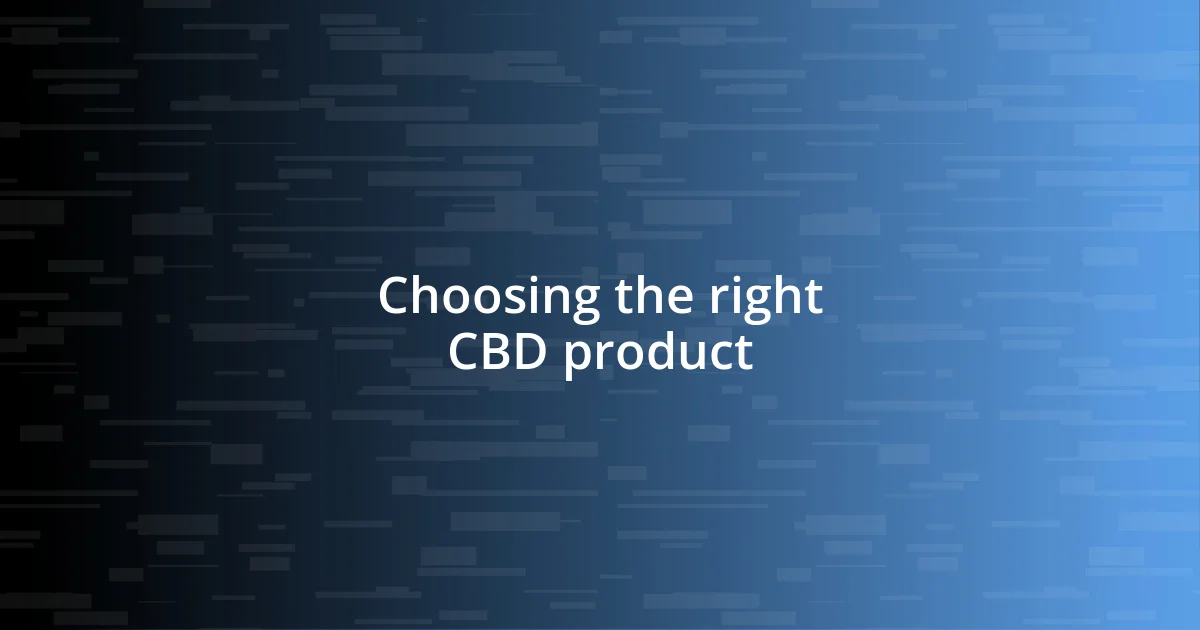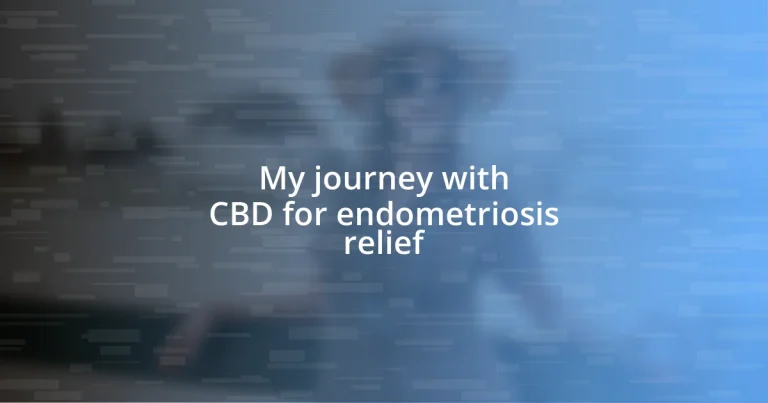Key takeaways:
- Endometriosis symptoms can be physical, emotional, and debilitating, highlighting the need for understanding and effective management strategies.
- CBD offers potential relief for endometriosis symptoms, including pain, inflammation, anxiety, and sleep disturbances, providing a natural alternative to conventional treatments.
- Choosing the right CBD product involves understanding different forms, verifying quality through third-party testing, and exploring beneficial CBD-to-THC ratios for personalized relief.

Understanding endometriosis symptoms
Endometriosis can manifest in a variety of ways, often leaving those affected feeling bewildered and isolated. I’ve experienced days where the pain was so intense that just getting out of bed felt like an insurmountable challenge. Have you ever felt that kind of ache, deep and unrelenting, which makes it hard to focus on anything else? It’s not just a physical sensation; it can invade every aspect of your life.
The symptoms extend beyond abdominal pain. For me, the fatigue that accompanies endometriosis was often just as debilitating. Have you noticed that you’re more tired than usual, even after a full night’s sleep? This exhaustion can be all-consuming, leaving little room for the things you enjoy. It’s like being trapped in a fog, where every effort feels like climbing a mountain.
Another aspect that shouldn’t be overlooked is the emotional toll these symptoms can take. The anxiety of not knowing when the next episode of pain will strike can sometimes overshadow even the brightest days. I remember feeling a wave of frustration wash over me, questioning why my body reacted this way. Have you found yourself grappling with that same sense of uncertainty and helplessness? Understanding these symptoms brings clarity, and it’s essential to navigate not just the physical challenges but also the emotional landscape that accompanies them.

Exploring conventional treatment options
Exploring conventional treatment options for endometriosis often feels overwhelming, given the variety of therapies available. In my experience, hormonal treatments like birth control pills aim to control the hormones that contribute to the growth of endometrial tissue. While it can be a relief to reduce symptoms, I’ve found that the side effects can sometimes be just as challenging—like mood swings or weight gain. Have you ever felt hesitant to start a treatment due to fear of these consequences?
Surgery is another avenue many consider. For instance, my friend opted for laparoscopy to remove cysts and scar tissue. I remember her recounting the relief she felt post-surgery, but it also came with a recovery period that was anything but easy. The idea of going under the knife can be daunting, especially when you’re weighing the risks and benefits. What do you think drives the decision for surgical intervention?
Medication options, from NSAIDs to more specialized prescriptions, can provide temporary pain relief. I often relied on over-the-counter options, but they didn’t always take the edge off. It’s a deeply personal journey in finding what combination works, which can lead to feelings of frustration and hopelessness when relief seems just out of reach.
| Conventional Treatment Options | Pros | Cons |
|---|---|---|
| Hormonal Treatments | Might reduce symptoms | Possible side effects |
| Surgery | Can remove tissue and cysts | Recovery time and risks |
| Medications (NSAIDs) | Immediate pain relief | Temporary and varying effectiveness |

Introduction to CBD and its uses
Cannabidiol, or CBD, has emerged as a notable player in the realm of natural remedies. I’ve found it intriguing how this compound, derived from hemp plants, interacts with our body’s endocannabinoid system to promote balance and wellness. Many people, including myself, are turning to CBD for its potential to relieve a range of symptoms, especially those associated with chronic conditions like endometriosis.
Here’s a closer look at some of the common uses of CBD:
- Pain Relief: Many users report significant reductions in pain, which can be particularly beneficial for endometriosis-related discomfort.
- Anti-Inflammatory: CBD may help reduce inflammation, potentially addressing one of the root issues in endometriosis.
- Anxiety Management: I’ve noticed that CBD can have calming effects, helping to ease the anxiety that often accompanies chronic pain conditions.
- Sleep Improvement: A restful night can be hard to come by when pain disrupts your daily routine. CBD has shown promise in promoting better sleep quality.
- Menstrual Support: Some women have found CBD to be a natural ally in managing menstrual cramps and associated symptoms.
What resonates with me is how CBD offers a potential alternative to conventional treatments, providing relief without the sometimes overwhelming side effects. It’s refreshing to explore a solution that feels more in tune with my body. My journey with CBD was borne out of necessity, and I’ve appreciated each small step it has provided toward reclaiming a sense of normalcy amidst the chaos of endometriosis.

How CBD can alleviate pain
Navigating pain relief with CBD has been a game changer for me. I vividly recall the first time I tried a CBD oil tincture; the sense of tightness slowly melted away after just a few drops. It felt almost surreal, as if I was finally able to breathe deeply again. I have often wondered, could this be the life-altering solution I’ve been searching for?
What’s fascinating is that CBD doesn’t just target pain directly; it also engages with the body’s endocannabinoid system to promote overall balance. I’ve noticed that on days when my pain levels tend to skyrocket, a simple dose can help soothe not only the physical discomfort but also the underlying tension that accompanies it. Have you ever experienced that dual layer of relief? It’s like lifting a fog that has settled over both your body and mind.
Most remarkably, CBD has become part of my routine, providing a sense of control in a chaotic time. I used to dread the onset of my pain, but now, I approach those challenging moments with a toolkit in hand—my oil, some calming tea, and the knowledge that relief is just around the corner. This holistic approach is refreshing, as it feels more like a partnership with my body rather than a battle against it. Has anyone else found that when you embrace alternatives, you begin to reclaim not just your body, but also your life?

Personal experiences with CBD use
I remember feeling skeptical when I first considered trying CBD. After reading about its benefits, I decided to give it a shot. The first night I took a CBD gummy before bed, I felt a wave of calm wash over me. For the first time in months, I drifted off to sleep without tossing and turning, and waking up the next day without that nagging fatigue made me wonder: could something so simple be the key to better rest?
As I continued to experiment with different forms of CBD, like capsules and topical balms, I noticed my approach to managing endometriosis shifted. One evening, after a particularly grueling day, I applied a CBD-infused cream directly to my abdomen. Within minutes, the tightness eased, and it struck me how empowered I felt taking my relief into my own hands. Have you ever experienced relief that feels both surprising and comforting at the same time?
It wasn’t just the physical relief that stood out for me; it was how positively it impacted my mental well-being. The anxiety that often accompanied my pain began to dissipate after incorporating CBD into my routine. I still remember the day I confidently joined a gathering of friends, something I had avoided for so long due to discomfort. That night, I savored not just the absence of pain but the joy of connection—something I’d almost forgotten. Isn’t it amazing how a natural remedy can change not only your body but also how you interact with the world around you?

Choosing the right CBD product
Choosing the right CBD product can seem daunting, especially with so many options available. Initially, I felt overwhelmed by the different forms—oils, edibles, topicals—each promising relief in their own unique way. I found it helpful to start with what felt right for my lifestyle. After trying a few different forms, I discovered that tinctures suited my needs perfectly because of their quick onset and dose flexibility. Have you ever wondered how you could truly find the best fit for your own journey?
I remember standing in front of a shelf filled with CBD products, scrutinizing labels for clarity. That’s when I became aware of the importance of third-party lab testing. This not only reassured me about the product’s quality but also provided insights into the cannabinoid content. The first product I truly trusted had a clear certificate of analysis, and I felt an immediate sense of relief. Have you thought about how knowing the source can make a difference in your overall experience?
Another crucial aspect for me has been understanding the CBD-to-THC ratio. I was initially hesitant about THC, but I discovered that even a small amount can enhance the effects of CBD. I remember trying a 1:1 CBD/THC tincture for the first time and feeling a gentle wave of relief wash over me. It was enlightening to realize that achieving balance can be a nuanced process, one that requires a little experimentation to find just the right mix for your needs. Have you explored what ratios might be beneficial for you?

Tips for effective CBD integration
Integrating CBD into your daily routine can be more effective when you start small. I remember my first week, I introduced one CBD gummy in the evening and kept track of how my body responded. By easing into it, I was able to notice the subtle changes in my mood and pain levels—almost like my body was thanking me for listening to its needs. Have you thought about how a measured approach can help you discover what works best?
Timing is another crucial aspect of effective CBD integration. When I began taking it regularly, I quickly learned that consistency played a huge role in my overall experience. I found taking CBD around the same time every day helped stabilize my mental and physical health. It’s like establishing a routine for a workout; have you ever noticed how regularity can build a solid foundation for improvement?
Finally, I encourage you to keep a journal. Recording my feelings before and after taking CBD helped me pinpoint what worked and what didn’t. By writing down specifics—whether it was a reduction in pain or a boost in energy—I gained valuable insight into my body’s responses. Have you considered that this simple practice could guide you toward a more effective CBD experience?














